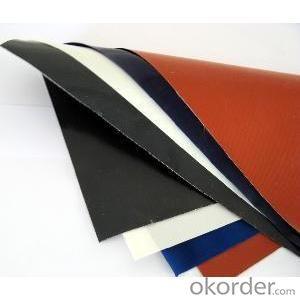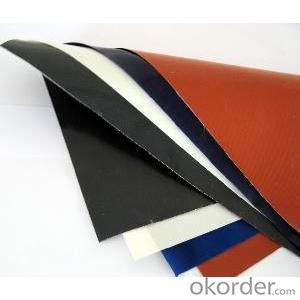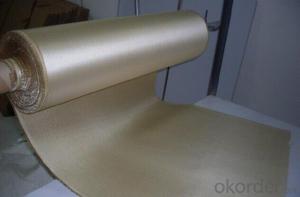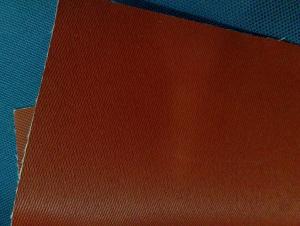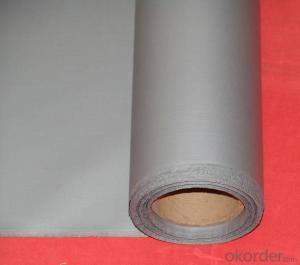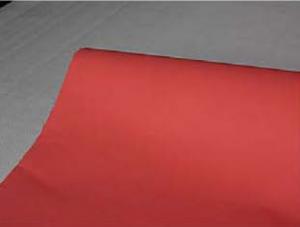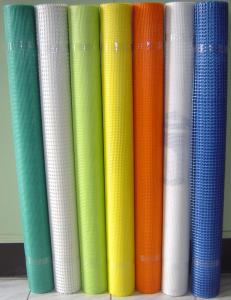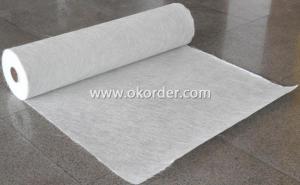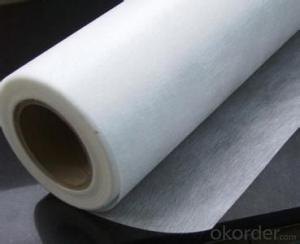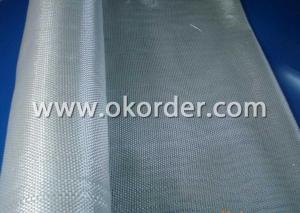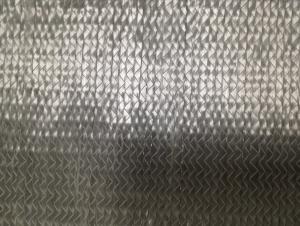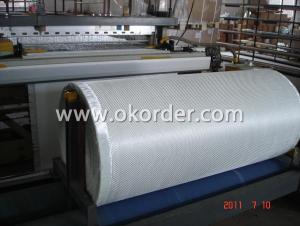Fiberglass cloth Coated with Silicon Rubber
- Loading Port:
- Shanghai
- Payment Terms:
- TT OR LC
- Min Order Qty:
- 10000 m²
- Supply Capability:
- 500000 m²/month
OKorder Service Pledge
OKorder Financial Service
You Might Also Like
Desciption:
Coated Fiberglass Fabric is made of high performance fiberglass fabric impregnated with PTFE suspension emulsion. It is a high performance, multi-use new composite material.Because of its high perforemance. It is widely used in aviation, paper, food, environmental protection, printing & dyeing, apparels, chemicals, glass, pharmaceuticals, electronics, insulation, construction ( membrane ceiling structure), grinding wheel, mechanical and so on.
Features:
1. High&low temperature endurable:
It can be used for longterm with its performance unchanged under the high temperature range from 200°C to 700°C and low temperature range from -50°C to 70°C.
2. Non-tick:
Any material is not easy to stick to it. And any stain or spot on it is easy to be cleaned away.
3. Chemical corrosion resistant:
It can resist strong acid, strong alkali, aqua regia, various organic solvents, and almost all pharmaceutical items.
4.High weatherability, anti-aging, anti-UV ray. DuPont company made an experiment and discovered that it can be placed in outside fields for thirty years with its performance unchanged.
5. High insulation property (the value of dielectric constant is only 2.6, and the value of tangent is less than 0.0025), anti-static, and the value of its surface resistance up to 1016 ohms.
6. Fire proof. Even flame cannot cause it burning.
Application of PTFE coated glass fabric:
1. Oven and microwave oven liner in Food processing.
By its high temperature resistance and nonstick characteristic, it can be made into oven liner and microwave oven liner,etc in food processing.
2. Conveyor belt: Various types of conveyor belts can be made from different thicknesses of PTFE coated glass fabric ranging from 0.06mm-1.7mm. Those with thickness of and above 0.45mm can be made into conveyor belt while those with thickness less than 0.45mm can be made into fusing machine belt, sealing belt,etc.
3. Chemical piping connection and covering material, used as vibration insulator and anti-corrosion layer; equipment protective layer, such as power plant desulfurizing unit. 4.Electrical appliances material, by its good insulation property.
5. Fireproof materials: it can be used for firewall and other fire prevention construction. 6.Demoulding materials. 7: welding blanket protecting from molten metal splash.
- Q: Are fiberglass fabrics suitable for use in the agricultural industry?
- Yes, fiberglass fabrics are suitable for use in the agricultural industry. They offer various benefits such as exceptional strength, durability, and resistance to chemicals, pests, and environmental elements. Fiberglass fabrics can be used for crop protection, greenhouse construction, animal housing, and other agricultural applications.
- Q: Can fiberglass fabrics be used for insulation in buildings?
- Yes, fiberglass fabrics can be used for insulation in buildings.
- Q: Can fiberglass fabric be used for insulation panels?
- Yes, fiberglass fabric can be used for insulation panels. Fiberglass is a versatile material that is commonly used for insulation due to its excellent thermal properties. It has a low thermal conductivity, which means it can effectively prevent heat transfer. Fiberglass fabric can be used to create insulation panels by layering it between other materials such as foam or rigid boards. This combination helps to trap air and reduce heat flow, making it ideal for insulating walls, ceilings, and floors. Fiberglass fabric is lightweight, durable, and fire-resistant, making it a popular choice for insulation applications.
- Q: How to use silica gel cloth and glue?
- The former is nylon, glass fiber and other materials on the coating of liquid silicone rubber, and its bonding can be used at room temperature, slow dry glue
- Q: Can fiberglass fabric be used for making welding curtains?
- Indeed, fiberglass fabric possesses the capability to be utilized in the creation of welding curtains. Renowned for its exceptional heat resistance traits, fiberglass fabric emerges as a fitting substance for safeguarding against the emergence of sparks and flames that welding activities generate. Notably, it endures elevated temperatures and impedes the propagation of fire, thereby establishing itself as a secure and efficacious preference for welding curtains. Furthermore, the durability and commendable tear resistance of fiberglass fabric ensure its capacity to endure the arduous conditions inherent in a welding setting.
- Q: Is fiberglass fabric suitable for use in aerospace interiors?
- Aerospace interiors can benefit greatly from the use of fiberglass fabric. This material is well-known for its exceptional strength-to-weight ratio and fire resistance, making it an ideal choice for various applications in the aerospace industry. It is commonly utilized in the construction of aircraft interiors, such as walls, ceilings, seats, and insulation. One of the main reasons why fiberglass fabric is favored in aerospace interiors is its impressive strength. It offers exceptional durability and can withstand the demanding conditions and vibrations experienced during flights. Moreover, its lightweight nature helps to reduce the overall weight of the aircraft, leading to improved fuel efficiency. Another significant advantage of fiberglass fabric is its inherent fire resistance. This is crucial for ensuring the safety of both passengers and crew members. In the event of a fire, fiberglass fabric will not ignite or contribute to the spread of flames. This provides valuable time for evacuation and minimizes the risk of a catastrophic incident. Additionally, fiberglass fabric is highly versatile and can be easily molded and shaped to fit the specific design requirements of aerospace interiors. It can be used as a structural material, providing stiffness and support, or as a decorative element, enhancing the aesthetic appeal of the cabin. To summarize, fiberglass fabric offers numerous advantages that make it an excellent choice for use in aerospace interiors. Its strength, lightweight nature, fire resistance, and versatility contribute to the safety, durability, and functionality of aircraft cabins.
- Q: Can fiberglass fabric be used for making conveyor belts or hoses?
- Conveyor belts or hoses can indeed utilize fiberglass fabric. Renowned for its exceptional strength and durability, fiberglass fabric proves itself as an optimal material for diverse industrial uses. Its capacity to endure high temperatures, resist chemicals and abrasions, and exhibit minimal moisture absorption renders it highly desirable for conveyor belts and hoses. Furthermore, fiberglass fabric's lightweight and flexible nature facilitates effortless installation and maneuvering. Ultimately, the incorporation of fiberglass fabric in the production of conveyor belts or hoses substantially amplifies their efficiency and longevity.
- Q: Can fiberglass fabric be used for making car seat covers?
- Yes, fiberglass fabric can be used for making car seat covers. Fiberglass fabric is known for its durability, strength, and resistance to heat, making it a suitable material for car seat covers. It is also lightweight and easy to work with, making it a popular choice for automotive applications. Additionally, fiberglass fabric is resistant to staining and can be easily cleaned, which is essential for car seat covers that are prone to spills and dirt. However, it is important to note that fiberglass fabric can be less comfortable compared to other materials, so additional padding or cushioning may be required to provide a comfortable seating experience.
- Q: How to distinguish the good and bad of aluminum foil glass fiber cloth? What is the plain glass fiber cloth, glass fiber cloth and twill satin glass cloth?
- Aluminum foil composite glass fiber cloth adopts unique advanced composite process, with composite aluminum foil surface smooth and smooth, high light reflectivity, vertical and horizontal tensile strength, airtight, waterproof, good sealing performance.
- Q: Is fiberglass fabric resistant to fire?
- Yes, fiberglass fabric is resistant to fire. Fiberglass is made from fine fibers of glass that are woven into a fabric. The glass fibers have a high melting point, which means they do not easily catch fire or burn. Additionally, fiberglass fabric is often treated with fire-resistant coatings or chemicals to enhance its fire resistance properties. This makes it an excellent choice for applications where fire resistance is required, such as protective clothing, insulation materials, and fireproof curtains. However, it is important to note that while fiberglass fabric is resistant to fire, it is not completely fireproof and can still melt or degrade under extreme heat conditions.
Send your message to us
Fiberglass cloth Coated with Silicon Rubber
- Loading Port:
- Shanghai
- Payment Terms:
- TT OR LC
- Min Order Qty:
- 10000 m²
- Supply Capability:
- 500000 m²/month
OKorder Service Pledge
OKorder Financial Service
Similar products
Hot products
Hot Searches
Related keywords
